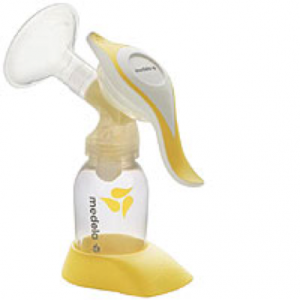This week has been absolutely incredible. Mikaela and I started getting our hands dirty, delving deeper into brainstorming, how mechanisms on a mechanical breast pump work, and decision-making.
Monday, we began by searching for homemade breast pumps online. Although we could not find any for women, we did find many videos of people trying to make mechanisms to milk their goats. Since cycles of negative pressure are needed for both processes, we watched some of these videos, though most were based on an electric power source (which our device must not use). Later that morning, we went to A Woman’s Work, a breastfeeding supply store, and spoke to some of their employees who were very knowledgeable on the subject of pumps and breastfeeding. They told us about differences between hospital-grade, single, and double electric pumps and mechanical pumps as well as the different audiences to which they cater. In the US, women who pump regularly and often tend to prefer double electric or hospital grade while those who pump only rarely generally only have a mechanical pump. They also spoke to us about the different parts of a breast pump and the importance of various parts. For example, it is extremely important that the breast shield is the correct size. If it is too small, it can damage the nipple while pumping, causing nipple trauma. We purchased a Medela hand pump (the most common mechanical breast pump) and returned to Rice with the challenge if figuring out exactly how it works.
Monday afternoon, we had another fantastic opportunity. We visited Mrs. Lauren Gray, who used to work at Rice 360, at her home to speak with her about her experiences breastfeeding and the various pumps she has used. We learned about more of the troubles of breastfeeding and walked away with a wealth of knowledge.
For the remainder of Monday and Tuesday, Mikaela and I dissected the Medela pump. We learned how it creates pressure, where the air and milk travel, how it releases pressure, and so much more. It is an extremely simple design, but we were constantly impressed by the small details that drastically increase the usability. For example, the handle of the pump can rotate around the diaphragm and the sides are different lengths. It is designed so the short side is pumped during the beginning of an expression session during the stimulation stage, when shallow, rapid cycles are needed. The mother can then switch to the longer arm of the pump during the expression phase, when slow, deep cycles are more effective.
Wednesday, we looked for alternative mechanisms that use a comfortable motion (such as tapping your foot) to do work. We set out to discover how a salad spinner and a pottery wheel work, thinking we could use the rotational motion to power a peristaltic pump or a cam. However, whenever we searched “how salad spinners work”, “DIY salad spinner” or “salad spinner mechanism”, we received information that was not on point. Apparently, salad spinners are complicated enough to use that they necessitate many YouTube videos specifying the precise strategy with which lettuce must be placed in the colander, the colander closed, and… wait for it… the button pressed. Crazy, I know. The hardest part seems to be taking out the colander and putting the lettuce in another bowl. The DIY salad spinners seemed even more complicated. You lie out a towel, put the salad on the towel, and spin the towel with your arm.
Once we finished brainstorming, we began the process of screening and scoring. We ran both matrices and got results, but upon evaluating the results we received, we noticed that the designs we felt would be most user-friendly had faired rather poorly, due in part to their higher cost. The winning two designs were inexpensive but we felt as though our criteria were not fitting to our vision for the design. I felt guilty – I do not want to build a device that causes unnecessary discomfort when I know there are better designs available, but I know that it is important that the hospital is able to afford the device. Thus, we decided to slightly edit the criteria and run the matrices again, eliminating the ideas that would be too difficult to construct and putting a greater emphasis on the comfort of the user. After making these changes, we redid our Pugh Screening Matrix with more favorable results. We will run the Scoring Matrix Monday to select 1 or 2 designs with which we can move on to the prototyping stage.
Frida, in addition to running the Screening matrix, each team gave a presentation to update all of the interns and the mentors on our progress. Hearing the progress that all of the teams have made in 2 weeks was astounding and I am so excited to see where all of these projects go.
